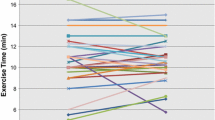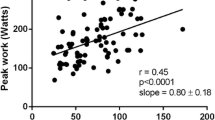Abstract
Debate on the proper timing of pulmonary valve replacement (PVR) after repair of tetralogy of Fallot is still continuing. We aim to clarify how the different components of right ventricle (RV) changed with relieved volume overload in the remodeling process after pulmonary valve replacement and gain a clear idea of the relationship between different right ventricle components function and exercise capacity after PVR in these patients. The medical records and results of cardiac magnetic resonance imaging and cardiopulmonary exercise testing of 25 consecutive eligible patients were reviewed. End-diastolic, end-systolic, and ejection fraction (EF) were determined for the total RV and its components before and after PVR. There was a marked increase in EF for the outlet after PVR (39.5 ± 11.4 vs. 45.6 ± 12.7, P = 0.04); however, EF and volume change for the other components showed no significant difference. Peak oxygen consumption (VO2) correlated better with the RV outflow tract EF than with the EF of other components of the RV or the global EF (r = 0.382, P = 0.018), and the time interval between initial repair and PVR showed a significant correlation with peak VO2 (r = −0.339, P = 0.037). Multivariate analysis showed the RV outflow tract EF to be the only independent predictor of exercise capacity (β = 0.479; P = 0.046). The systolic function of the RV outflow tract could be a reliable determinant of intrinsic RV performance in repaired TOF (rTOF) patients and a promising parameter for deciding timing of pulmonary valve replacement so as to achieve the best possible exercise capacity in repaired TOF patients.

Similar content being viewed by others
References
Harrild DM, Berul CI, Cecchin F et al (2009) Pulmonary valve replacement in tetralogy of Fallot. Circulation 119(3):445–451
Hickey EJ, Veldtman G, Bradley TJ et al (2009) Late risk of outcomes for adults with repaired tetralogy of Fallot from an inception cohort spanning four decades. Eur J Cardiothorac Surg 35(1):156–164
Coats L, Khambadkone S, Derrick G et al (2007) Physiological consequences of percutaneous pulmonary valve implantation: the different behaviour of volume- and pressure-overloaded ventricles. Eur Heart J 28(15):1886–1893
Therrien J, Siu SC, McLaughlin PR et al (2000) Pulmonary valve replacement in adults late after repair of tetralogy of Fallot: are we operating too late? J Am Coll Cardiol 36(5):1670–1675
Jacques D, Delahaye JP, Gare JP et al (1995) Radionuclide ejection fraction at rest and in exercise in chronic aortic insufficiency. Pre- and postoperative study in asymptomatic or paucisymptomatic patients. Archives des maladies du coeur et des vaisseaux 88(9):1301–1306
Carabello BA, Crawford FA Jr (1997) Valvular heart disease. N Engl J Med 337:32–41
Anderson RH, Baker EJ, Redington AN (2000) Can we describe structure as well as function when accounting for the arrangement of the ventricular mass? Cardiol Young 10(03):247–260
Sheehan F, Redington A (2008) The right ventricle: anatomy, physiology and clinical imaging. Heart 94(11):1510–1515
Bodhey NK, Beerbaum P, Sarikouch S et al (2008) Functional analysis of the components of the right ventricle in the setting of tetralogy of Fallot. Circulation: Cardiovasc Imaging 1(2):141–147
van der Hulst AE, Roest AAW, Holman ER et al (2011) Real-time three-dimensional echocardiography: segmental analysis of the right ventricle in patients with repaired tetralogy of Fallot. J Am Soc Echocardiogr 24(11):1183–1190
Burnside WS, Snowden C (2014) Physiological basis of preoperative cardiopulmonary exercise testing. Surgery (Oxford) 32(2):59–62
Fratz S, Chung T, Greil GF et al (2013) Guidelines and protocols for cardiovascular magnetic resonance in children and adults with congenital heart disease: SCMR expert consensus group on congenital heart disease. J Cardiovasc Magn Reson 15(1):51
Lim C, Lee JY, Kim WH et al (2004) Early replacement of pulmonary valve after repair of tetralogy: is it really beneficial? Eur J Cardiothorac Surg 25(5):728–734
Warner KG, O’Brien PKH, Rhodes J et al (2003) Expanding the indications for pulmonary valve replacement after repair of tetralogy of Fallot. Ann Thorac Surg 76(4):1066–1071
Atallah-Yunes NH, Kavey RE, Bove EL et al (1996) Postoperative assessment of a modified surgical approach to repair of tetralogy of Fallot. Long-term follow-up. Circulation 94(9 Suppl):22–26
Roest AAW, Helbing WA, Kunz P et al (2002) Exercise MR Imaging in the assessment of pulmonary regurgitation and biventricular function in patients after tetralogy of Fallot repair 1. Radiology 223(1):204–211
Yap J, Le Tan J, Le TT et al (2014) Assessment of left ventricular preload by cardiac magnetic resonance imaging predicts exercise capacity in adult operated tetralogy of Fallot: a retrospective study. BMC Cardiovasc Disord 14(1):122
Bove T, Vandekerckhove K, Devos D et al (2013) Functional analysis of the anatomical right ventricular components: should assessment of right ventricular function after repair of tetralogy of Fallot be refined? Eur J Cardiothorac Surg 45(2):e6–e12
Luo S, Li J, Yang D, et al (2017) Right ventricular outflow tract systolic function correlates with exercise capacity in patients with severe right ventricle dilatation after repair of tetralogy of Fallot. Interact Cardiovasc Thorac Surg
Geva T (2011) Repaired tetralogy of Fallot: the roles of cardiovascular magnetic resonance in evaluating pathophysiology and for pulmonary valve replacement decision support. J Cardiovasc Magn Reson 13(1):9
Ho JG, Schamberger MS, Hurwitz RA et al (2015) The effects of pulmonary valve replacement for severe pulmonary regurgitation on exercise capacity and cardiac function. Pediatr Cardiol 36(6):1194–1203
O’Meagher S, Munoz PA, Muthurangu V et al (2014) Mechanisms of maintained exercise capacity in adults with repaired tetralogy of Fallot. Int J Cardiol 177(1):178–181
Author information
Authors and Affiliations
Corresponding author
Ethics declarations
Conflict of interest
The authors declare that they have no conflict of interest.
Ethical approval
All procedures performed in studies involving human participants were in accordance with the ethical standards of the institutional and/or national research committee and with the 1964 Helsinki declaration and its later amendments or comparable ethical standards.
Informed consent
For this type of study formal consent is not required.
Rights and permissions
About this article
Cite this article
Li, J., Luo, S., Liu, F. et al. Systolic Function of Right Ventricular Outflow Tract is a Better Predictor to Exercise Performance After Pulmonary Valve Replacement in Tetralogy of Fallot. Pediatr Cardiol 38, 1556–1561 (2017). https://doi.org/10.1007/s00246-017-1695-5
Received:
Accepted:
Published:
Issue Date:
DOI: https://doi.org/10.1007/s00246-017-1695-5




